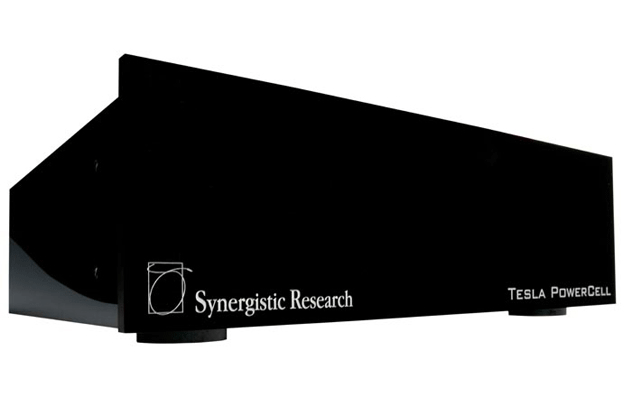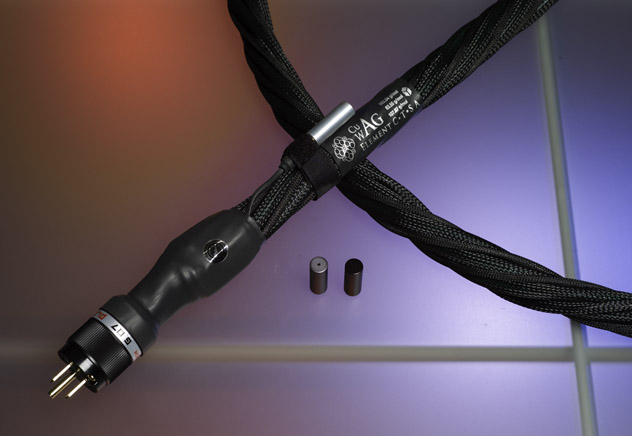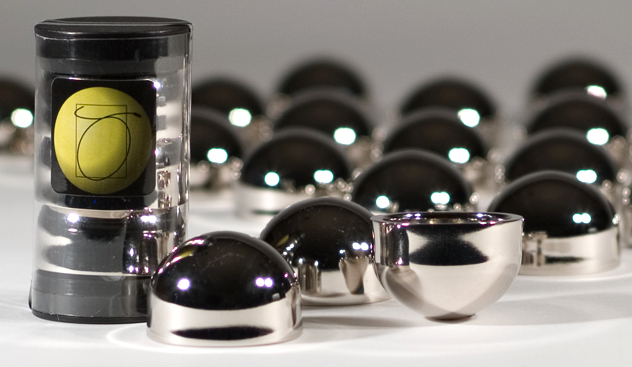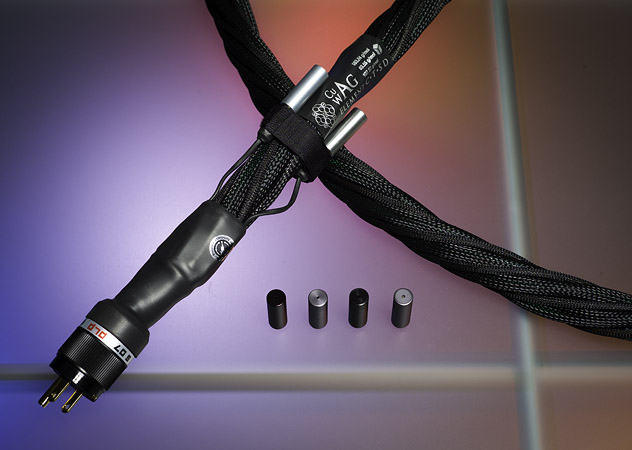Synergistic Research PowerCell 10 SE MKIII, Element Series AC Cords, and MiGs
|
|
|
|
 My first experience with a Synergistic Research (herein SR) product was the groundbreaking A/C Master Coupler back in 1995. At the time, I started with a solid-state based system consisting of Adcom separates (amplifier, preamp, and CD player), Snell E-III loudspeakers, and Monster Cable wires to an upgraded tube based system consisting of Golden Tube Audio SE separates, California Audio Labs CL-15, B&W P5 loudspeakers, M&K subwoofer, and Audioquest cables. In the process of trading and upgrading tweaks and cables with fellow audiophiles, a friend recommended that I try the SR A/C Master Couplers. At the time, SR was the only cable company marketing upgraded power cords. Although I had my doubts that a power cable could have an impact on my system, I had my local dealer supply me with three SR A/C Master Couplers. I installed them on my source, tube preamp, and tube amplifier. With the SR A/C Master Couplers installed I immediately detected a lower noise floor with a velvety black background. As you might have guessed, I became interested in replacing of my existing speaker and interconnect cables with SR cables. Since then, like most of us die-hard audio geeks that got to have the latest technology within (economic) reason, I’ve taken the cable merry-go-round a few times. Fast forward to 2012, SR is now celebrating their 20 year anniversary in the cable business. There has always been stiff completion in the audio cable business and I’m glad to still have these as a reference.
My first experience with a Synergistic Research (herein SR) product was the groundbreaking A/C Master Coupler back in 1995. At the time, I started with a solid-state based system consisting of Adcom separates (amplifier, preamp, and CD player), Snell E-III loudspeakers, and Monster Cable wires to an upgraded tube based system consisting of Golden Tube Audio SE separates, California Audio Labs CL-15, B&W P5 loudspeakers, M&K subwoofer, and Audioquest cables. In the process of trading and upgrading tweaks and cables with fellow audiophiles, a friend recommended that I try the SR A/C Master Couplers. At the time, SR was the only cable company marketing upgraded power cords. Although I had my doubts that a power cable could have an impact on my system, I had my local dealer supply me with three SR A/C Master Couplers. I installed them on my source, tube preamp, and tube amplifier. With the SR A/C Master Couplers installed I immediately detected a lower noise floor with a velvety black background. As you might have guessed, I became interested in replacing of my existing speaker and interconnect cables with SR cables. Since then, like most of us die-hard audio geeks that got to have the latest technology within (economic) reason, I’ve taken the cable merry-go-round a few times. Fast forward to 2012, SR is now celebrating their 20 year anniversary in the cable business. There has always been stiff completion in the audio cable business and I’m glad to still have these as a reference.
It’s been said before and it’s worth repeating: “It all starts at the AC wall socket.” The quality, structure, and efficiency of the AC entering your music system play a profound role in the musicality and dimensionality of the music your system can reproduce. The power supplies within your audio components simply do not have the ability to clear the incoming AC of all radio frequency interference (RFI), digital noise, and electro-magnetic interference (EMI), and other electrical disturbances that household AC brings when it enters your home. It’s simply not their job. This is the job of the AC line conditioner.
My review will start with baselining the PowerCell 10SE Mk II, which I have had in my system for the last fourteen months. I will then review the new SR Element AC power cables plugged into the PowerCell 10SE Mk II. The next step will include swapping in the PowerCell 10SE Mk III and comparing it directly to the older Mk II version. Finally, I will install the MiG (mechanical interface grounding) footers on my source components and compare their performance to my existing isolation footers.
PowerCell 10SE Mk III
 The SR PowerCell 10SE Mk III consists of ten (10) SR TeslaPlex SE outlets or five (5) isolated circuits, an active Electromagnetic Cell, and a Neutrik 32 amp PowerCon connector, all housed in an electromagnetically and mechanically inert SAR Acrylic chassis. Included with the PowerCell 10SE Mk III is a 5ft Element Copper Tungsten power cable which has the ability to change the voicing via Enigma Tuning bullets and a dual Mini Power Coupler that provides active shielding. The SR Element Copper Tungsten power cable replaces the Precision AC Tesla Se included on the previous model, PowerCell 10SE MKII, which by itself retails for $1800. As in the previous model, all components of the PowerCell 10SE Mk III are “Quantum Tunnel’d” (see the description below). The main differences between the MKII and MKIII, are the redesign of the EM Cell ground plane which was conceived during the development of the SR Tranquility Base and the addition of precious metals at critical points within the EM Cell structure. As compared to the design of many other power conditioners in the marketplace which contain transformers, chokes, etc. in the conductor signal path, the EM Cell acts passively to condition AC with differential EM fields resulting in an AC power conditioner that is non-current limiting.
The SR PowerCell 10SE Mk III consists of ten (10) SR TeslaPlex SE outlets or five (5) isolated circuits, an active Electromagnetic Cell, and a Neutrik 32 amp PowerCon connector, all housed in an electromagnetically and mechanically inert SAR Acrylic chassis. Included with the PowerCell 10SE Mk III is a 5ft Element Copper Tungsten power cable which has the ability to change the voicing via Enigma Tuning bullets and a dual Mini Power Coupler that provides active shielding. The SR Element Copper Tungsten power cable replaces the Precision AC Tesla Se included on the previous model, PowerCell 10SE MKII, which by itself retails for $1800. As in the previous model, all components of the PowerCell 10SE Mk III are “Quantum Tunnel’d” (see the description below). The main differences between the MKII and MKIII, are the redesign of the EM Cell ground plane which was conceived during the development of the SR Tranquility Base and the addition of precious metals at critical points within the EM Cell structure. As compared to the design of many other power conditioners in the marketplace which contain transformers, chokes, etc. in the conductor signal path, the EM Cell acts passively to condition AC with differential EM fields resulting in an AC power conditioner that is non-current limiting.
Element Series Power Cables

The Element Series power cables are the next progression in technology, superseding the Tesla SE series and being evolved from SR’s the top tier Galileo series cables. Attributes of the Element Series includes active shielded air dielectrics, pure Copper, Tungsten, and Silver signal conductors, Enigma Tuning Circuits, Quantum Tunneling, and 100% gold signal/ground conductors (wall plugs and IEC connectors). The five models in the Element Series power cables include: Element Copper, Element Tungsten, Element Copper/Tungsten, Element Copper/Tungsten/Silver Analogue, and Element Copper/Tungsten/Silver Digital and range in price from $650 to $3000.
All Element power cables include a set of Enigma Tuning bullets and a Mini Power Coupler (MPC) that provides active shielding. The Enigma Tuning bullets, which run in parallel to the active shielding, come in three favors (silver, black and grey) which allow the end user to fine tune the voicing of the power cord. It’s like having three power cables in one. The sonic characteristics can be summarized as follows:
• Silver – open and airy
• Black – warm and rich
• Grey – hybrid of Silver and Black
The active shielding is designed to reject noise from the local power station riding on the incoming AC lines and to isolate electrical line cross contamination between system components. In addition to the Enigma Tuning circuits and active shielding, all components of the cable and MPC receive a defined “Quantum Tunnel” treatment. Per the SR website, “Quantum Tunneling is a process that changes the way a cable conducts signal at the subatomic level, affecting the entire cable assembly: connectors (RCA, XLR, spade, or banana), solder joints, dielectric, and signal & ground conductors are all transformed and integrated as a single unit. By applying a two million volt signal to a cable at a specific pulse modulation, and ultra-high frequency for an exact duration of time, the entire cable is transformed at a molecular level through a phenomenon called Quantum Tunneling”.
MiGs (Mechanical Interface Grounding)

The MiG (Mechanical Interface Grounding) footers are based on the SR Acoustic Art System resonators. According to the SR website, the MiGs “… re-tune a component’s mechanical resonance, while providing a lightning fast drain of mechanical energy to ground.” SR recommends the placement of the MiGs in two configurations: ambient and pin-point. The ambient set-up has two MiGs placed under a component “round side up” and one MiG placed “round side down”. The pin-point set-up has two MiGs placed under a component “round side down” and one MiG placed “round side up”. The pin-point configuration is said to be better suited to well damped rooms where as the ambient configuration performs its best in live or un-damped rooms. Starting with your source components (digital or analog based) and evaluating the two configurations as described above, is suggested. The MiGs are offered in two sizes (1.65” diameter x 1.09,” tall, and 1.9” diameter x 1.09” tall) and can be used under transports, DACs, turntables preamplifiers, amplifiers, conditioners, loudspeakers, and subwoofers.
The Fifth Element
My review system includes the Ayon Audio CD player, Laufer Teknik Memory Player 64 Full Version Player, Pioneer bdp-09fd blu ray player, Ayon Audio Triton MKII integrated amplifier fitted with Ayon BT SX KT88 power tubes and Mazda Cifte signal tubes, Acoustic Zen Crescendo loudspeakers, REL R-528 subwoofer, Klee Acoustics speaker cables and interconnects, Synergistic Research Tesla SE AC power cords, Synergistic Research PowerCell 10 SE MKII conditioner, Synergistic Research Tesla Plex SE outlets, Stein H2 Harmonizers and Magic Stones, Shatki Hallograph, Stillpoints Ultra 5s footers and LessLoss Blackbodies behind the AZ Crescendo loudspeaker crossovers . As for my listening area, its 14.5’ wide, has a 9’ ceiling, and has an open back wall to 1500 square f of first floor living area.
To maintain consistency within the review, I replaced the SR Tesla SE Hologram D power cable with a SR Tesla T3 power cable on the Laufer Teknik MP64 but kept the Precision Reference on the Ayon Audio Trition MKII. Since I have two dedicated lines and two main components in my reviewing system, I was able to remove SR PowerCell 10SE MKII from my system, listen to my system sans PowerCell 10SE MKII, then reinstall the PowerCell and evaluate its contribution alone.
SR PowerCell 10SE MKII
 Herbie Hancock’s, River: The Joni Letters [Verve Records] as an HDtracks 24 bit /96kHz download, has been getting its share of playtime over the last year. Initially I mainly listened to the fourth track, “River” but as time went on I started to really dig all music on this download. With my reviewing system fed by the Powercell 10SE MKII, it was easy to determine what areas of the sonic performance were transformed:
Herbie Hancock’s, River: The Joni Letters [Verve Records] as an HDtracks 24 bit /96kHz download, has been getting its share of playtime over the last year. Initially I mainly listened to the fourth track, “River” but as time went on I started to really dig all music on this download. With my reviewing system fed by the Powercell 10SE MKII, it was easy to determine what areas of the sonic performance were transformed:
a) The noise floor dropped to indiscernible levels allow for the finest details to be heard during loud dynamic swings while increasing the decay of notes.
b) The edge and smear of complex passages was eliminated allowing the music to portray its full emotion.
c) Instruments had a more natural tone with more precision and pin point placement.
d) The soundstage expanded in all directions with increased space around instruments.
e) The resolution, transparency, and dynamics were improved.
f) The lowest octaves were better defined.
g) The overall volume increased with better left to right separation.
To confirm this wasn’t the placebo affect at work here, I repeated the same test with my 17-year-old son (first chair saxophone in his high school band) located in my system’s sweet spot. My son agreed with me on all points listed above.
It was like a source of constriction affecting my entire reviewing system was liberated. Put in another way, it was like the power source or energy flow that drives all of my components was bottlenecked somewhere (or in some fashion) and the Powercell 10SE MKII removed the bottleneck. The macro dynamics of my Ayon Audio Trition II and REL R-528 powered subwoofer was enhanced when plugged into the PowerCell 10SE MKII versus plugged directly into the wall which was the opposite behavior with other power conditioners I’ve had in my system. The REL R-528 subwoofer disappeared and was better integrated with my main speakers when plugged into the PowerCell 10SE MKII.
As I listened more to my system, I noticed something fundamentally was changed. The nature of the change was both, subtle and pervasive, elusive and obvious at the same time. In a word … MICRODYNAMICS, which can be defined as subtle differences between small changes in volume over time, a characteristic that contributes to the uncanny realism of sound (for example, to hear the wobble of the skin of a tympani when you hear the strike of a tympani, when the blat of a muted trumpet has an internal echo, or when you can hear the neighboring strings of a piano when a key is struck). The PowerCell technology contributes to the microdynamic finesse like no other power conditioner I have ever used. Things like tonality, harmony, beat, tempo, syncopation, and melody, all became more convincingly true to life. Individual timbral qualities of the five basic categories of musical instruments—strings, woodwinds, brass, percussion, and keyboard instruments—were more natural. The music was also more coherent in both sound and time, much in the same way live music is more compelling than a recorded performance.
Listening to track 8, “Amelia” on the Herbie Hancock download, with the PowerCell 10SE MKII installed, my system’s noise floor dropped to vanishingly low levels allowing the music to take on a warmer, more natural, rounder and relaxed tone. With the help of the Powercell 10SE MKII, I could hear distinct characteristics of Luciana Souza’s vocal tones, felt the emotion she was conveying, and better appreciated her unique style of singing. I heard her voice go from soft to very loud and then quickly back down again while maintaining a consistent spatial relationship between the grand piano, tenor saxophone, guitar, and drums instruments. The tenor saxophone on “Sweet Bird,” just floated in space against a dead silent background. Over time, I found myself more and more drawn into the music as a result of the music being more pure, more truthful, and closer to a live performance. From top to bottom, all vocals and instruments on this 24 bit/ 96k Hz download sounded much better.
Element Power Cords

On my other evaluation recordings which (besides the Hancock recording) included, Diana Krall, Quiet Nights [The Verve Music Group], Robert Plant & Alison Krauss’, Raising Sand [Rounder], and This is K2 HD Sound [FIM], the Element Series power cables provided a more holographic image with enhanced front-to-back layering on all instruments. The resolution of the vocals, instruments, and recording venue was greatly enhanced. Jumping back to “Ameila” on the Hancock download, Luciana Souza’s voice had greater clarity and presence with the vibrato being more articulate while conveying a deeper emotional expression. You could also see the brushes being stroked as a result of the enhanced three-dimensional images. Improvements in the pitch definition on the bass guitar in that track were also achieved. On the first track of This is K2 HD Sound, the Element Series power cables provided clearer timbral distinctions between violins, viola, and cello, with a greater sense of textures of bow on strings and the deep bass crescendos were more explosive as compared to the equivalent SR Tesla Series power cables.
Alone, the Element Copper power cable contributed more to pin-point imaging while maintaining a neutral balance and enhancing clarity across the frequency spectrum. The Element power cable added its own mellow balance while adding to the three dimension reproduction of the music. My Acoustic Zen Crescendo speakers seemed to disappeared better with the Element power cables installed. Top to bottom, the Element Series was a better power cable indeed.
As with the PowerCell MKII, I used the Silver Enigma tuning bullets. One thing to note though … I found the flexibility of the tuning bullets to be very useful when I swapped in a more resolving KT-88 power tube set. In this instance, I had to dial down the high frequencies and the Grey Enigma tuning bullet did the trick.
SR PowerCell 10SE MKIII
I first read about the MKIII in one of last year’s CES Show Reports. At CES SR introduced their new Tranquility Base (three models), PowerCell 10SE Mk III, AC Master Coupler 20th Anniversary, Enigma Mk II valve power supply, Transporter solid state power supply, basik active series cables, and the Music Cable 24/192 SPDIF version DAC. Having the PowerCell MKII in my system and enjoying what it does, I couldn’t wait to try the PowerCell MKIII. I also mention that I allowed the PC MKIII’s to burn-in for at least 100 hours before engaging in any serious listening sessions. When I hit the play button on the LT MP64, I was immediately astonished by the difference. The PowerCell MKIII displayed all the same characteristics that I presented above (you name it) with regard to the MKII but on a much larger scale. The first difference to hit me was how the soundfield changed. The soundfield projected into the room like I added two side and two rear surround speakers with the sound emanating from only the front baffle of my AZ Crescendos. I’ve never experienced this perspective from a two channel system in the last 10 years of reviewing. The space between instruments was nothing like I have ever heard. I was amazed at the size, depth and truthfulness of the grand piano and tenor saxophone on the Hancock recording and how large the voices of Nora Jones, Tina Turner, Corinne Bailey Rae, Joni Mitchell and Luciana Souza were in my listening room. The second biggest change was the enhancement of micro-dynamic shadings. This change brought my system as close to the live recording as I have ever experienced. I sat there in disbelief. The third biggest difference occurred in the bass frequencies. The need for my REL R-528 subwoofer to assist the lowest octaves for music was greatly diminished. The bass was much bolder with better speed, finesse and control. The fourth significant difference was the ambience retrieval. I really had a “you are there” sense of the recording venue. The fifth and last significant difference which contributed to all other improvements in some way was the nonexistent noise floor which was already extremely low on the PowerCell MKII. These same improvements discussed above were also confirmed one of my other reference recordings, This is K2 HD Sound. In summary, music played through the PowerCell MKIII was more dramatic, bigger, more exciting, more complex, and more captivating.
The PowerCell MKIII was not just a slight revision of the PowerCell MKII but an entirely different power conditioner. I believe all due to the incorporation of the Tranquility Base ground plane and the use of the Element Series power cable.
MiGs
I first tried the MiGs under my Pioneer Elite Blu-Ray player and then under the Laufer Teknik MP64. It’s amazing how changing the orientation (ambient or pinpoint) changed the spatial relationship, image focus, resolution, layering, and overall clarity by lowering the noise floor. In my system, I preferred the pinpoint configuration over the ambient on both sources. Since my LT MP64 was fitted with the OEM Stillpoints Ultra footers made from aluminum, this made for an interesting comparison against the SR MiGS. It was no contest. The MiGs were clearly better in all areas. They improved my system in areas that I didn’t realize could be improved. I was particularly taken by the how the midrange texture became richer and the bass frequencies were deeper on my reference recordings. The SR MiGs are a must have component.
Summary and Conclusions
The Synergistic Research PowerCell 10SE MKIII and Element Series AC power cables are engineering breakthroughs that are well made, deliver on their promised performance, and have taken my system to a level I never thought possible. They improve all areas of the sonic performance yet provide a more natural and musical presentation which is not commonly seen in audio. The great thing about these products is that once purchased, you can forget about that link in your audio system. “Synergistic” is how I would describe the effect and approach of these products in one’s system. They are my new reference.


Specifications:
PowerCell 10 SE MK III, $5500
• Contsruction: SAR Acrylic
• Dimensions: Height 5.625″ x Width 17.75″ x Depth 14″
• Weight: 19 lbs.
• Connector Input: 1 each Neutrik 32 amp PowerCon
• US Connectors Output: 10 each Synergistic Research TeslaPlex SE
• Euro Connectors Output: 10 each Synergistic Research TeslaPlex Schuko
Voltage and current Rating
• Input Rating: 32 amp/250v
• US Version: This rating is predicated upon the US Outlet rating of 20amp/125v
• Euro Version: This rating is predicated upon the Shuko Outlet rating of 16amp/250v
Element Tungsten AC Power Cord, 5ft, $900
Element Copper AC Power Cord, 5ft, $1800
MiGs (Mechanical Interface Grounding), $150
Address:
Synergistic Research, Inc.
17401 Armstrong Avenue
Suite 102
Irvine, CA 92614
Website: www.synergisticresearch.com
Telephone: +1(800) 578-6489 within US and +1(949) 476-0000 outside the US
Associated Equipment:
Digital Front End
Laufer Teknik Memory Player 64 Full Version (with V-cap upgrade)
Ayon Audio CD-2 cd player
Pioneer Elite bdp-09fd blu-ray player
Amplification
Ayon Audio Triton MKII
Loudspeakers
Acoustic Zen Crescendo loudspeakers
REL R-528 subwoofer
Cabling
Klee Acoustics speaker cables, double shotgun run
Klee Acoustics Interconnect, balanced
Klee Acoustics Interconnect, single ended
Synergistic Research Tesla SE Hologram D power cord
Synergistic Research Tesla SE Precision AC power cord
Synergistic Research Tesla SE T3 power cord
Synergistic Research Element Tungsten ACpower cord
Synergistic Research Element Copper Tungsten AC power cord
Synergistic Research Tesla LE REL SPEC Subwoofer Reference
AC Conditioners
Synergistic Research PowerCell 10 SE MKII
Synergistic Research PowerCell 10 SE MKIII
Accessories
Stein H2 Harmonizers x 4 and Magic Stones
Stillpoints Ultra 5s on AZ Crescendo loudspeakers
LessLoss Blackbody ambient field conditioner x 2
Custom built maple wood rack with stainless steel support rod, sleeves, and cones
Mazda Cifte 12AU7 signal tubes sourced from Upscale Audio
Shatki Holograms
Marigo Labs Window Tuning Dots
Herbie’s Audio Lab Preamp Ultrasonic tube dampers
Synergistic Research Tesla Plex SE wall outlets
Synergistic Research Quantum Fuses
Oyaide WPC-Z aluminum mounting frame and carbon fiber faceplates
Two dedicated 20 amp AC lines using cryo treated Romex
Rosinante Dark Matter cable towers
![]()
Stereo Times Masthead
Publisher/Founder
Clement Perry
Editor
Dave Thomas
Senior Editors
Frank Alles, Mike Girardi, Russell Lichter, Terry London, Moreno Mitchell, Paul Szabady, Bill Wells, Mike Wright, and Stephen Yan,
Current Contributors
David Abramson, Tim Barrall, Dave Allison, Ron Cook, Lewis Dardick, John Hoffman, Dan Secula, Don Shaulis, Greg Simmons, Eric Teh, Greg Voth, Richard Willie, Ed Van Winkle, Rob Dockery, Richard Doran, and Daveed Turek
Site Management Clement Perry
Ad Designer: Martin Perry





Be the first to comment on: Synergistic Research PowerCell 10 SE MKIII, Element Series AC Cords, and MiGs